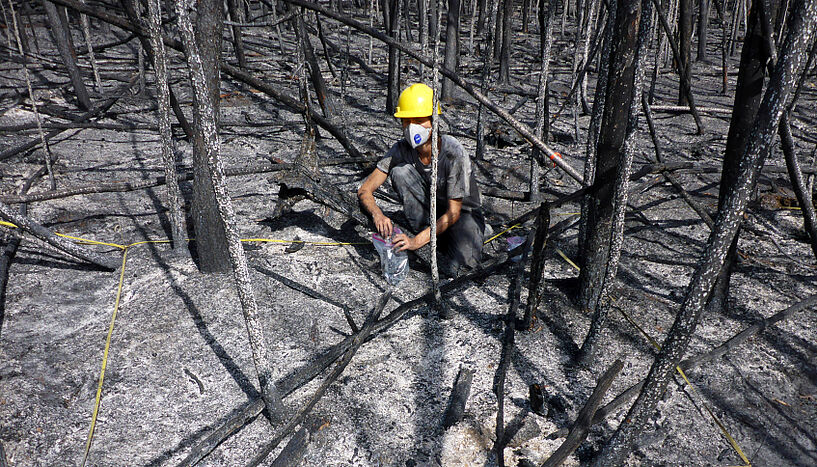The persistent danger after landscape fires
26. März 2021
In samples from ten different fires, the researchers detected EPFR in concentrations that exceeded those typically found in soils by as much as ten to a thousand times. (© Stefan Doerr)
Carbonized plants contain harmful free radicals
Every year, an estimated four percent of the world's vegetated land surface burns, leaving more than 250 megatons of carbonized plants behind. For the first time, a study by the University of Vienna has now recorded elevated concentrations of environmentally persistent free radicals (EPFR) in these charcoals - in some cases even up to five years after the fire. These EPFR may generate reactive substances, which in turn harm plants and living organisms. The research team led by Gabriel Sigmund and Thilo Hofmann analyzed charcoal samples collected from forest, shrubland and grassland fires in different climatic zones. The study is published in Nature Communications Earth & Environment.
Reactive oxygen species (ROS) cause oxidative stress at the cellular level. Research shows that this way, amongst others, they inhibit the germination capacity of plants, produce cytotoxins or exert toxic effects on aquatic invertebrates. Environmentally persistent free radicals (EPFR) are potential precursors of ROS because they can react with water to form these radical species. "Therefore, EPFR are associated with harmful effects on the ecosystem and human health," explains Gabriel Sigmund, the lead investigator of the study.
"Our study shows that these environmentally persistent free radicals can be found in large quantities and over a long period of time in fire derived charcoal," reports Sigmund, environmental geoscientist at the Center for Microbiology and Environmental Systems Science (CMESS) at the University of Vienna. In all 60 charcoal samples from ten different fires, the researchers detected EPFR in concentrations that exceeded those typically found in soils by as much as ten to a thousand times. Other than expected, this concentration remained stable for at least five years, as an analysis of charcoal samples showed which were gathered at the same location and over several years after a forest fire. "The more stable the environmentally persistent free radicals are, the more likely it is that they will have an impact on ecosystems over longer periods of time," explains Thilo Hofmann, co-author of the study and head of the research group.
Samples from fires in forest, shrubland and grassland spanning different climates
The researchers collected charcoal samples from fires of diverse intensity in boreal, temperate, subtropical, and tropical climates. They considered forest, shrubland and grassland fires and, thus, also different fuel materials (woods and grasses). The original material and the charring conditions determine the degree of carbonization. Consequently, both indirectly influence the extent to which EPFR are formed and how persistent they are. "The analyses show that the concentration of environmentally persistent free radicals increased with the degree of carbonization," Sigmund reports. Woody fuels favored higher concentrations. For these, the researchers were also able to demonstrate the stability of EPFR over several years. "We assume that woody wildfire derived charcoal is a globally important source of these free radicals and thus potentially also of harmful reactive oxygen species," adds Hofmann.
International collaboration across disciplines
"It is our collaboration with colleagues at Swansea University in the United Kingdom that enables us to make these highly differentiated statements," explains Sigmund. The wildfire experts at Swansea University are conducting global research into the effects of fire on environmental processes such as the carbon cycle and erosion. They have collected charcoal samples from around the world and sent them to Vienna for analysis, along with information on the timing, duration and intensity of the fires. CMESS researchers analyzed the samples in collaboration with Marc Pignitter of the Faculty of Chemistry using electron spin resonance spectroscopy (ESR spectroscopy). ESR spectroscopy made it possible to quantify the environmentally persistent free radicals in the studied material and to identify their adjacent chemical structures.
Questions about consequences for the ecosystem
The study has provided insights, but also raised further questions: The fact that environmentally persistent free radicals occur in such high concentrations and remain stable over several years was surprising. In future studies, the researchers are planning to also assess the consequences this may have for the environment. "To what extent is this a stress factor for microorganisms after a fire? How does it affect an ecosystem? The study is an impetus for further research," reports Sigmund.
Publication in Communications Earth & Environment:
G. Sigmund, C. Santín, M. Pignitter, N. Tepe, S. H. Doerr, T. Hofmann, Environmentally persistent free radicals are ubiquitous in wildfire charcoals and remain stable for years. Communications Earth & Environment (2021), DOI: 10.1038/s43247-021-00138-2
Wissenschaftlicher Kontakt
Dr. Gabriel Sigmund
Zentrum für Mikrobiologie und Umweltsystemwissenschaft1090 - Wien, Althanstraße 14
+43-1-4277-53392
gabriel.sigmund@univie.ac.at
Rückfragehinweis
Alina Birkel, BA BA
Pressebüro der Universität WienUniversität Wien
1010 - Wien, Universitätsring 1
+43-1-4277-175 36
+43-664-60277-175 36
alina.birkel@univie.ac.at
Downloads:
web2.jpg
Dateigröße: 704,07 KB
